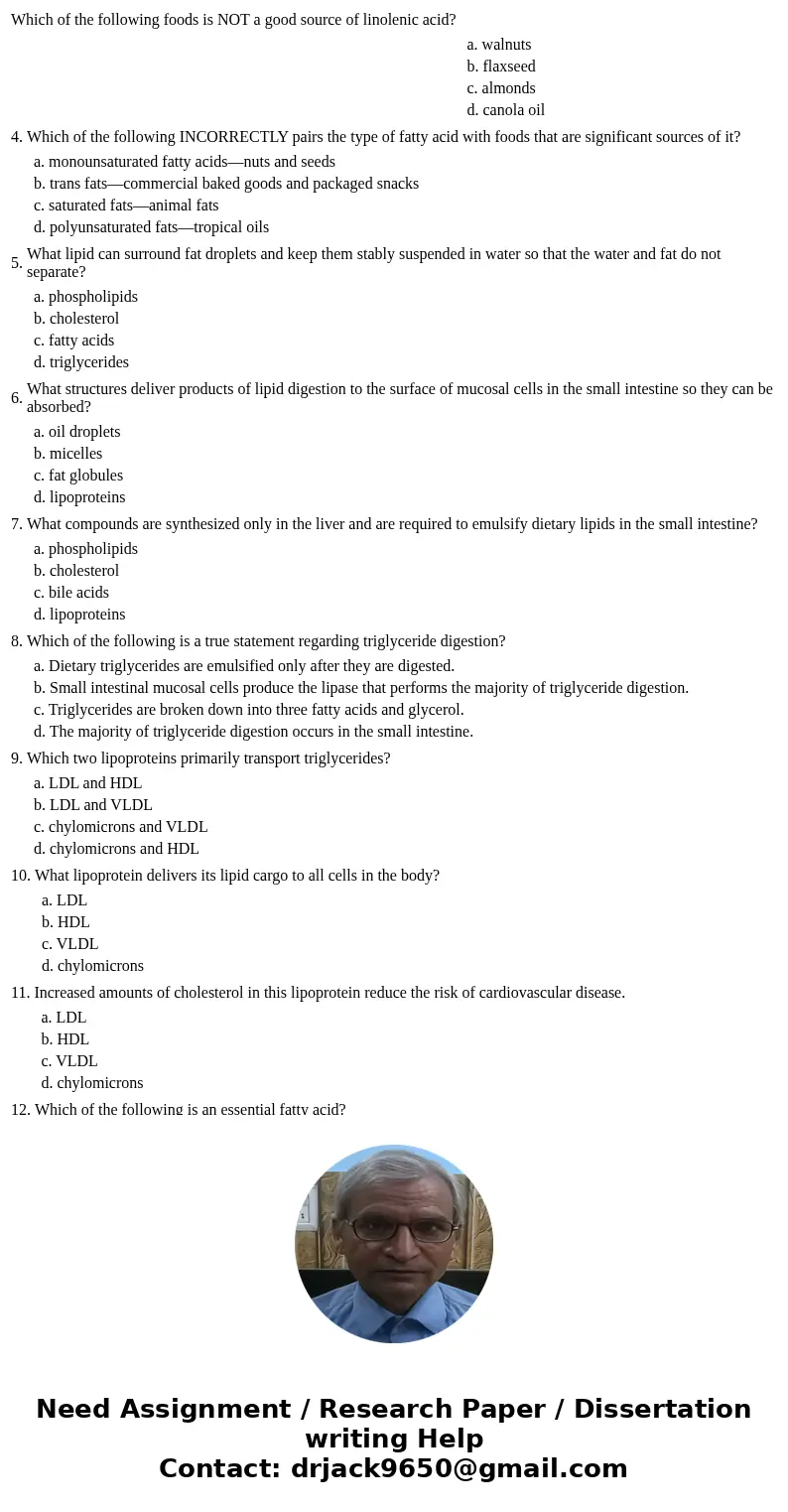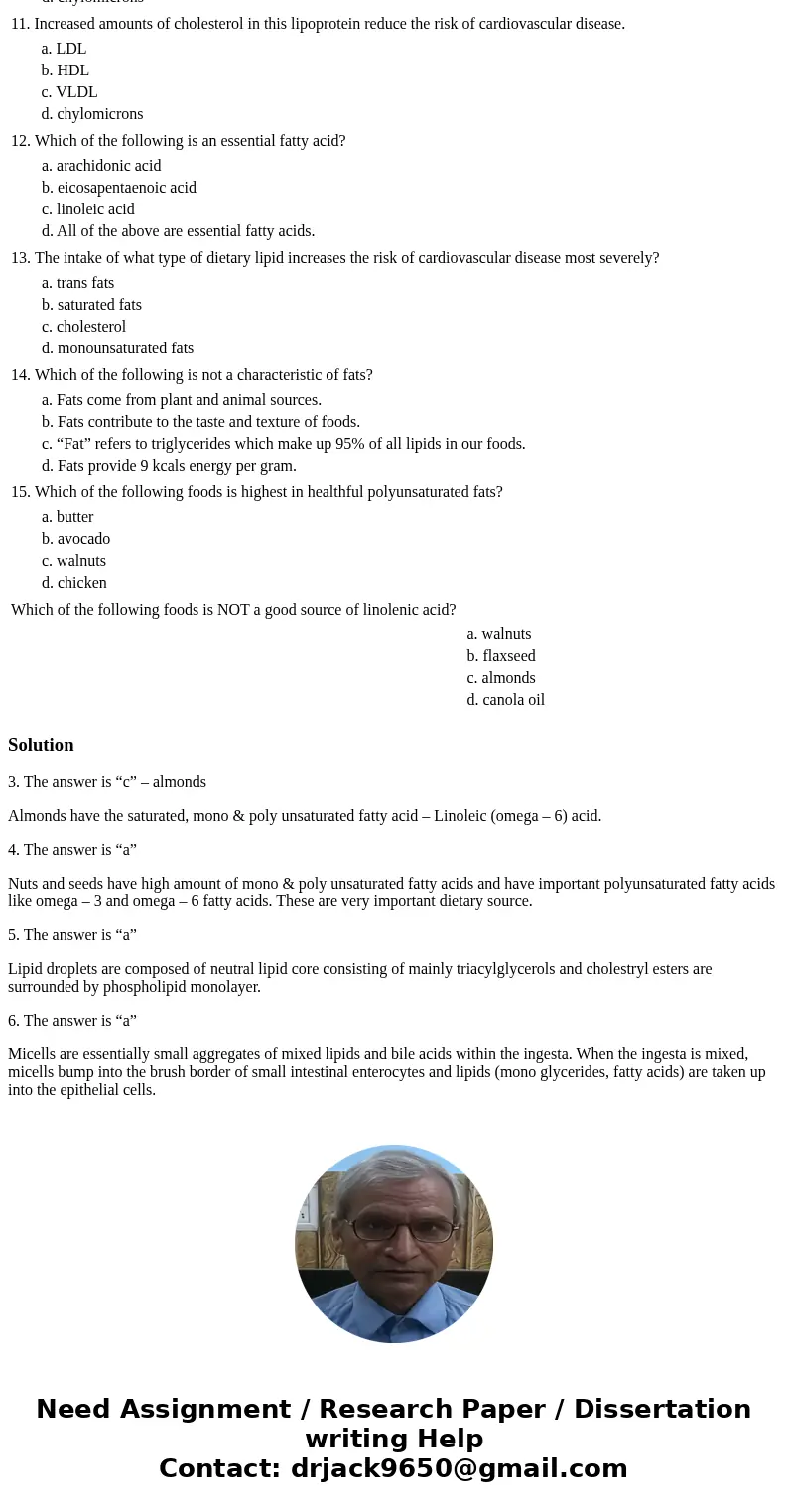| Which of the following foods is NOT a good source of linolenic acid? |
| | a. walnuts | | b. flaxseed | | c. almonds | | d. canola oil | |
| 4. | Which of the following INCORRECTLY pairs the type of fatty acid with foods that are significant sources of it? |
| | a. monounsaturated fatty acids—nuts and seeds | | b. trans fats—commercial baked goods and packaged snacks | | c. saturated fats—animal fats | | d. polyunsaturated fats—tropical oils | |
| 5. | What lipid can surround fat droplets and keep them stably suspended in water so that the water and fat do not separate? |
| | a. phospholipids | | b. cholesterol | | c. fatty acids | | d. triglycerides | |
| 6. | What structures deliver products of lipid digestion to the surface of mucosal cells in the small intestine so they can be absorbed? |
| | a. oil droplets | | b. micelles | | c. fat globules | | d. lipoproteins | |
| 7. | What compounds are synthesized only in the liver and are required to emulsify dietary lipids in the small intestine? |
| | a. phospholipids | | b. cholesterol | | c. bile acids | | d. lipoproteins | |
| 8. | Which of the following is a true statement regarding triglyceride digestion? |
| | a. Dietary triglycerides are emulsified only after they are digested. | | b. Small intestinal mucosal cells produce the lipase that performs the majority of triglyceride digestion. | | c. Triglycerides are broken down into three fatty acids and glycerol. | | d. The majority of triglyceride digestion occurs in the small intestine. | |
| 9. | Which two lipoproteins primarily transport triglycerides? |
| | a. LDL and HDL | | b. LDL and VLDL | | c. chylomicrons and VLDL | | d. chylomicrons and HDL | |
| 10. | What lipoprotein delivers its lipid cargo to all cells in the body? |
| | a. LDL | | b. HDL | | c. VLDL | | d. chylomicrons | |
| 11. | Increased amounts of cholesterol in this lipoprotein reduce the risk of cardiovascular disease. |
| | a. LDL | | b. HDL | | c. VLDL | | d. chylomicrons | |
| 12. | Which of the following is an essential fatty acid? |
| | a. arachidonic acid | | b. eicosapentaenoic acid | | c. linoleic acid | | d. All of the above are essential fatty acids. | |
| 13. | The intake of what type of dietary lipid increases the risk of cardiovascular disease most severely? |
| | a. trans fats | | b. saturated fats | | c. cholesterol | | d. monounsaturated fats | |
| 14. | Which of the following is not a characteristic of fats? |
| | a. Fats come from plant and animal sources. | | b. Fats contribute to the taste and texture of foods. | | c. “Fat” refers to triglycerides which make up 95% of all lipids in our foods. | | d. Fats provide 9 kcals energy per gram. | |
| 15. | Which of the following foods is highest in healthful polyunsaturated fats? |
| | a. butter | | b. avocado | | c. walnuts | | d. chicken | |
| Which of the following foods is NOT a good source of linolenic acid? |
| | a. walnuts | | b. flaxseed | | c. almonds | | d. canola oil | |
3. The answer is “c” – almonds
Almonds have the saturated, mono & poly unsaturated fatty acid – Linoleic (omega – 6) acid.
4. The answer is “a”
Nuts and seeds have high amount of mono & poly unsaturated fatty acids and have important polyunsaturated fatty acids like omega – 3 and omega – 6 fatty acids. These are very important dietary source.
5. The answer is “a”
Lipid droplets are composed of neutral lipid core consisting of mainly triacylglycerols and cholestryl esters are surrounded by phospholipid monolayer.
6. The answer is “a”
Micells are essentially small aggregates of mixed lipids and bile acids within the ingesta. When the ingesta is mixed, micells bump into the brush border of small intestinal enterocytes and lipids (mono glycerides, fatty acids) are taken up into the epithelial cells.


 Homework Sourse
Homework Sourse